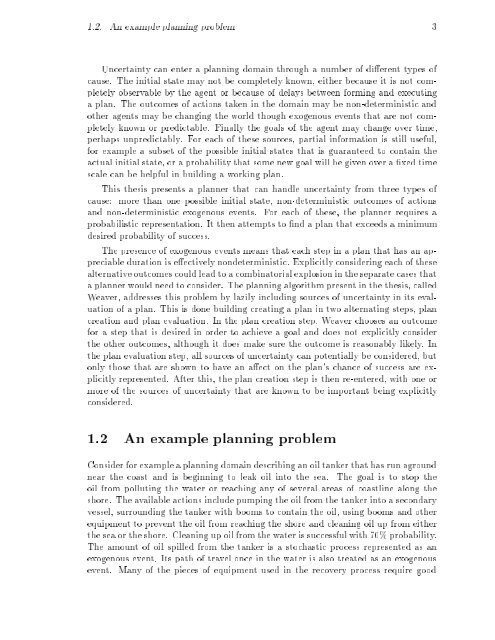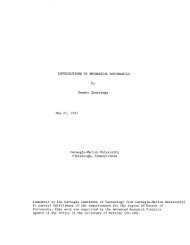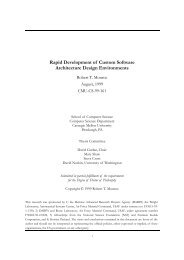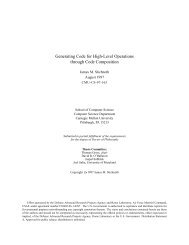Planning under Uncertainty in Dynamic Domains - Carnegie Mellon ...
Planning under Uncertainty in Dynamic Domains - Carnegie Mellon ...
Planning under Uncertainty in Dynamic Domains - Carnegie Mellon ...
Create successful ePaper yourself
Turn your PDF publications into a flip-book with our unique Google optimized e-Paper software.
1.2. An example plann<strong>in</strong>g problem 3<strong>Uncerta<strong>in</strong>ty</strong> can enter a plann<strong>in</strong>g doma<strong>in</strong> through a number of dierent types ofcause. The <strong>in</strong>itial state may not be completely known, either because it is not completelyobservable by the agent or because of delays between form<strong>in</strong>g and execut<strong>in</strong>ga plan. The outcomes of actions taken <strong>in</strong> the doma<strong>in</strong> may be non-determ<strong>in</strong>istic andother agents may bechang<strong>in</strong>g the world though exogenous events that are not completelyknown or predictable. F<strong>in</strong>ally the goals of the agent maychange over time,perhaps unpredictably. For each of these sources, partial <strong>in</strong>formation is still useful,for example a subset of the possible <strong>in</strong>itial states that is guaranteed to conta<strong>in</strong> theactual <strong>in</strong>itial state, or a probability that some new goal will be given over a xed timescale can be helpful <strong>in</strong> build<strong>in</strong>g a work<strong>in</strong>g plan.This thesis presents a planner that can handle uncerta<strong>in</strong>ty from three types ofcause: more than one possible <strong>in</strong>itial state, non-determ<strong>in</strong>istic outcomes of actionsand non-determ<strong>in</strong>istic exogenous events. For each of these, the planner requires aprobabilistic representation. It then attempts to nd a plan that exceeds a m<strong>in</strong>imumdesired probability of success.The presence of exogenous events means that each step <strong>in</strong> a plan that has an appreciableduration is eectively nondeterm<strong>in</strong>istic. Explicitly consider<strong>in</strong>g each of thesealternative outcomes could lead to a comb<strong>in</strong>atorial explosion <strong>in</strong> the separate cases thata planner would need to consider. The plann<strong>in</strong>g algorithm present <strong>in</strong> the thesis, calledWeaver, addresses this problem by lazily <strong>in</strong>clud<strong>in</strong>g sources of uncerta<strong>in</strong>ty <strong>in</strong> its evaluationof a plan. This is done build<strong>in</strong>g creat<strong>in</strong>g a plan <strong>in</strong> two alternat<strong>in</strong>g steps, plancreation and plan evaluation. In the plan creation step, Weaver chooses an outcomefor a step that is desired <strong>in</strong> order to achieve a goal and does not explicitly considerthe other outcomes, although it does make sure the outcome is reasonably likely. Inthe plan evaluation step, all sources of uncerta<strong>in</strong>ty can potentially be considered, butonly those that are shown to have an aect on the plan's chance of success are explicitlyrepresented. After this, the plan creation step is then re-entered, with one ormore of the sources of uncerta<strong>in</strong>ty that are known to be important be<strong>in</strong>g explicitlyconsidered.1.2 An example plann<strong>in</strong>g problemConsider for example a plann<strong>in</strong>g doma<strong>in</strong> describ<strong>in</strong>g an oil tanker that has run agroundnear the coast and is beg<strong>in</strong>n<strong>in</strong>g to leak oil <strong>in</strong>to the sea. The goal is to stop theoil from pollut<strong>in</strong>g the water or reach<strong>in</strong>g any ofseveral areas of coastl<strong>in</strong>e along theshore. The available actions <strong>in</strong>clude pump<strong>in</strong>g the oil from the tanker <strong>in</strong>to a secondaryvessel, surround<strong>in</strong>g the tanker with booms to conta<strong>in</strong> the oil, us<strong>in</strong>g booms and otherequipment to prevent the oil from reach<strong>in</strong>g the shore and clean<strong>in</strong>g oil up from eitherthe sea or the shore. Clean<strong>in</strong>g up oil from the water is successful with 70% probability.The amount of oil spilled from the tanker is a stochastic process represented as anexogenous event. Its path of travel once <strong>in</strong> the water is also treated as an exogenousevent. Many of the pieces of equipment used <strong>in</strong> the recovery process require good







